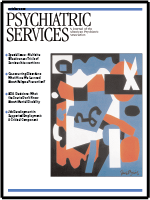Special Section on Relapse Prevention: Substance Abuse Relapse and Factors Associated With Relapse in an Inner-City Sample of Patients With Dual Diagnoses
Abstract
OBJECTIVE: This study documented rates of substance abuse relapse and explored factors associated with sustained remission among consumers with severe mental illness in a large, urban clinical sample. METHODS: Existing clinical records of consumers with severe mental illness and co-occurring substance use disorders who had achieved remission and who were interviewed at two or more subsequent follow-up points (12 months after remission) were reviewed. Consumers who relapsed within 12 months after remission were compared with those who maintained remission on demographic, clinical, and functional indicators. RESULTS: Of the 133 consumers who achieved remission, 91 (68 percent) had maintained remission at six-month follow-up, and 69 (52 percent) had maintained remission at 12-month follow-up. The strongest factors associated with maintenance of remission at 12 months were older age and living in Thresholds residential programs. Multivariate analysis showed that consumers who were older, held jobs, and lived in Thresholds residential programs at initial remission had a higher likelihood of maintaining remission at 12 months. To explore the potential impact of program dropout on the results, supplemental analyses using a third group without 12-month follow-up data were conducted. These analyses indicated that program dropouts were younger and less likely to live in Thresholds residential programs at initial remission. CONCLUSIONS: Age, therapeutic residential programming, and, to a lesser degree, employment appear to be potential factors to consider in the development of relapse prevention models.



